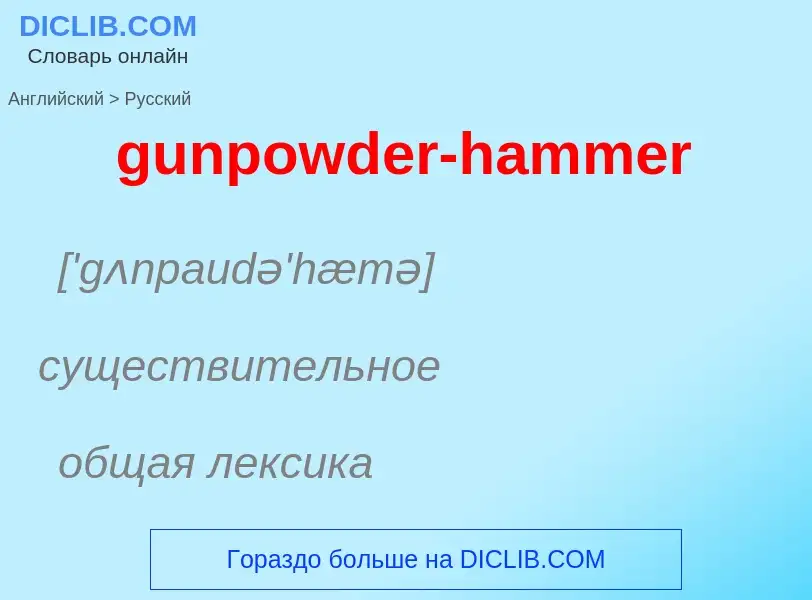Tradução e análise de palavras por inteligência artificial ChatGPT
Nesta página você pode obter uma análise detalhada de uma palavra ou frase, produzida usando a melhor tecnologia de inteligência artificial até o momento:
- como a palavra é usada
- frequência de uso
- é usado com mais frequência na fala oral ou escrita
- opções de tradução de palavras
- exemplos de uso (várias frases com tradução)
- etimologia
gunpowder-hammer - tradução para russo
['gʌnpaudə'hæmə]
существительное
общая лексика
пороховая копровая баба
[,gʌnpaudə'plɔt]
общая лексика
"Пороховой заговор" (5 ноября 1605; был устроен католиками с целью убийства короля Якова I [James I], кот. должен был прибыть на заседание парламента [Parliament]; под здание парламента подложили бочки с порохом; заговор был раскрыт)
синоним
Definição
Wikipédia

Gunpowder tea (Chinese: 珠茶; pinyin: zhū chá; lit. 'pearl tea'; pronounced [ʈʂú ʈʂʰǎ]) is a form of tea in which each leaf has been rolled into a small round pellet. Its English name comes from its resemblance to grains of gunpowder. This rolling method of shaping tea is most often applied either to dried green tea (the most commonly encountered variety outside China) or oolong tea.
Gunpowder tea production dates back to the Tang Dynasty 618–907. It was first introduced to Taiwan in the nineteenth century. Gunpowder tea leaves are withered, steamed, rolled, and then dried. Although the individual leaves were formerly rolled by hand, today all but the highest grade gunpowder teas are rolled by machines. Rolling renders the leaves less susceptible to physical damage and breakage and allows them to retain more of their flavor and aroma. In addition, it allows certain types of oolong teas to be aged for decades if they are cared for by being occasionally roasted.
Shiny pellets indicate that the tea is relatively fresh. Pellet size is also associated with quality, larger pellets being considered a mark of lower quality tea. High quality gunpowder tea will have small, tightly rolled pellets. The tea is divided into several grades using a combination of numbers and letters. As an example, 3505AAA is considered the highest grade while 9375 is a relatively lower grade.



![[[Bonfire]]s are lit in Britain every 5 November to commemorate the failure of the plot. [[Bonfire]]s are lit in Britain every 5 November to commemorate the failure of the plot.](https://commons.wikimedia.org/wiki/Special:FilePath/6 november bonfire from flickr user sjnikon.jpg?width=200)
![torture rack]] in the Tower of London torture rack]] in the Tower of London](https://commons.wikimedia.org/wiki/Special:FilePath/A Torture Rack.jpg?width=200)
![William Capon's map of Parliament clearly labels the [[undercroft]] used by "Guy Vaux" to store the gunpowder. William Capon's map of Parliament clearly labels the [[undercroft]] used by "Guy Vaux" to store the gunpowder.](https://commons.wikimedia.org/wiki/Special:FilePath/Capon map of parliament.jpg?width=200)
![[[Edward Coke]] conducted the interrogations of those thought to be involved with the conspiracy. [[Edward Coke]] conducted the interrogations of those thought to be involved with the conspiracy.](https://commons.wikimedia.org/wiki/Special:FilePath/Edward coke.jpg?width=200)
![Elizabeth]], whom the conspirators planned to install on the throne as a Catholic queen. Portrait by [[Robert Peake the Elder]], [[National Maritime Museum]]. Elizabeth]], whom the conspirators planned to install on the throne as a Catholic queen. Portrait by [[Robert Peake the Elder]], [[National Maritime Museum]].](https://commons.wikimedia.org/wiki/Special:FilePath/Eliz bohemia 2.jpg?width=200)
![[[Elizabeth I]], queen from 1558 to 1603 [[Elizabeth I]], queen from 1558 to 1603](https://commons.wikimedia.org/wiki/Special:FilePath/Elizabeth I George Gower.jpg?width=200)


![''The Discovery of the Gunpowder Plot and the Taking of Guy Fawkes'' (c. 1823) by [[Henry Perronet Briggs]]. ''The Discovery of the Gunpowder Plot and the Taking of Guy Fawkes'' (c. 1823) by [[Henry Perronet Briggs]].](https://commons.wikimedia.org/wiki/Special:FilePath/Guy fawkes henry perronet briggs.jpg?width=200)

![[[Hindlip Hall]] in [[Worcestershire]]. The building was destroyed by fire in 1820. [[Hindlip Hall]] in [[Worcestershire]]. The building was destroyed by fire in 1820.](https://commons.wikimedia.org/wiki/Special:FilePath/Hindlip hall.jpg?width=200)


![Old Palace of Westminster]]. The River Thames is to the right. Old Palace of Westminster]]. The River Thames is to the right.](https://commons.wikimedia.org/wiki/Special:FilePath/John rocque house of lords gunpowder plot cropped.jpg?width=200)

![Robert Cecil, <br /> 1st Earl of Salisbury. <br /> Painting by [[John de Critz]] the Elder, 1602. Robert Cecil, <br /> 1st Earl of Salisbury. <br /> Painting by [[John de Critz]] the Elder, 1602.](https://commons.wikimedia.org/wiki/Special:FilePath/Robert Cecil, 1st Earl of Salisbury by John De Critz the Elder (2).jpg?width=200)

![A contemporary engraving of eight of the thirteen conspirators, by [[Crispijn van de Passe]]. Missing are Digby, Keyes, Rookwood, Grant, and Tresham. A contemporary engraving of eight of the thirteen conspirators, by [[Crispijn van de Passe]]. Missing are Digby, Keyes, Rookwood, Grant, and Tresham.](https://commons.wikimedia.org/wiki/Special:FilePath/The Gunpowder Plot Conspirators, 1605 from NPG.jpg?width=200)
![Engraving of conspirators of the Gunpowder Plot being [[hanged, drawn and quartered]] in London. Engraving of conspirators of the Gunpowder Plot being [[hanged, drawn and quartered]] in London.](https://commons.wikimedia.org/wiki/Special:FilePath/The execution of Guy Fawkes' (Guy Fawkes) by Claes (Nicolaes) Jansz Visscher.jpg?width=200)
